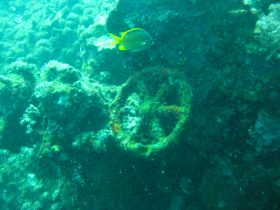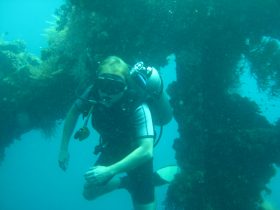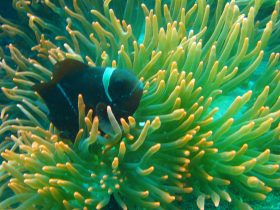The Liberty: Bali’s perfect shipwreck
 The Australian Way, April 2010
The Australian Way, April 2010
It is January 11, 1942, and the US army transport ship USAT Liberty is on its way from Australia to the Philippines with a hold full of rubber and railway parts. Near the Indonesian island of Lombok a Japanese submarine spots it and opens fire. The Liberty is torpedoed beneath the waterline.
The crew knows it’s sinking. But they have time to react, and two destroyers are swiftly enlisted to tow it to Singaraja, a port on the north coast of Bali, to save the ship, or at least its vital cargo. They don’t make it. But the destroyers do get it far enough to beach on Bali’s east coast at Tulamben, allowing the rubber and steel to be salvaged. And there the carcass sits for 21 years, stripped of all that’s useful from the ammunition to the deck wood, just a holed hulk on a Balinese pebble beach.
Then, in February 1963, Bali’s great volcano, Gunung Agung, starts smoking. It coincides with Eka Desa Rudra, a hugely significant traditional Balinese sacrifice that happens only once every 100 years, and locally the rumbling is seen as ominous portent. It certainly has quite an impact on the Liberty, for when the eruption comes on March 17 1963, the force is so extraordinarily violent that it moves the ship. As lava flows down the volcano’s sides, the Liberty shifts just a few metres offshore, then slides down the underwater slope on its side, submerged at last.
It’s a remarkable enough story already, but nobody could have imagined the gift that was to come of this erratic sequence of war, torpedo, beaching, volcano and descent. For in the almost 50 years since the Liberty finally sank, it has become home to an extraordinary abundance of coral and other sea life. Better still, it has become one of the most accessible wreck dives in the world.
You might call it a perfect storm, but a collision of positive rather than negative coincidences. The ship is 92 years old (it started out transporting horses in 1918) and has been fully submerged in the water for 47; long enough for an extravagantly complex ecosystem to develop, but young enough for the structure to remain superficially intact. It lies in warm, diver-friendly water, and could barely be in a better place for the development of sea life: oceanographers say its position on the northeast coast – an accident born of the fact that the crew could get the ship no further without it sinking – puts it in an ideal position to receive plankton-rich water from an ocean current moving from the Pacific to the Indian Ocean.
It sits in shallow water, just metres from a beach; you can swim out to it, and even snorkellers can usually get a clear view of the stern from the surface. Even at its deepest point at high tide, the wreck sits at less than 30 metres depth, and most of it touches the bottom at less than 20 metres and can be explored in detail at 10. That puts it within easy reach of divers who have completed only the most basic qualifications, such as the PADI Open Water certification, which has so far certified some 18 million people and is adding about 900,000 a year.
From a diver’s perspective, everything is on your side. There are professional and well-run dive shops providing smart and English-speaking accompanying guides; the volcanic sand, while tricky for distance visibility, provides a contrast that makes the corals look brighter and better in photos; and you have the consolation of knowing you’re not diving on a wreck that is also a tomb – a tricky ethical footnote in wreck diving – since the crew made it off safely when they beached it.
It has even had the decency to sink parallel to the beach, so that divers have a 120-metre wreck to explore at a more or less constant depth and are never far from shore. A perusal from stern to bow and back again fits perfectly with a 40-minute oxygen tank. You really couldn’t make it any better if you were trying to design it from scratch with divers in mind.
So what’s down there?
Local dive shops quote marine biologists who say there are 400 species of reef fish. Guides report seeing sunfish, rays, tuna and even whale sharks from time to time, but most of what you see is small and resplendently colourful. There are Finding Nemo-style clownfish, there are trevally and wrasse, anglerfish, pipefish, sweetlips and fusiliers. When The Australian Way dives, our guide points out what looks a lump of green and brown encrustation on a bulkhead; he taps it and an angry gaping mouth appears, and a view right into its body, a girder lattice of bleached white bone; it’s a scorpion fish.
The variety of coral in such a small space rivals anything you might see elsewhere: hard and soft, black and purple, brain coral, fan coral, staghorn, star. But more than anything, there’s the wreck. Divers walking in from the shore first sight it at barely five metres under the surface, as schools of fish are still visible circling on the surface above. As is common on wrecks, it’s not always possible to tell what you’re looking at: just fragmented steel beams, shapeless and lost beneath the extraordinary additional layer of coral life that has taken up residence on the hull. But then you catch sight of a wheel, crusted in sediment; an anchor chain; a gun barrel. And suddenly you are pitching in a dark southeast Asian sea in 1942, a ship taking on water, a Japanese submarine somewhere unseen, a race against time to reach land.
One of the great appeals of this dive is that it doesn’t require the specialist qualifications that wrecks often do, either for the depth or conditions involved, or the need to get into tight spaces to see it properly. The Liberty can be viewed perfectly well up close by anyone who knows how to use a regulator and a weight belt. It’s the most democratic wreck you could imagine.
On top of all this, of course, the Liberty lies off a holiday island that receives around two million tourist visits a year. It’s not a straightforward place to reach – Tulamben is about a two hour drive from the main drags of Sanur or Kuta, more in traffic, and it’s best to arrange your own transport. Most visitors will never know it’s there, preferring to stick with the beaches, or Ubud’s cultural attractions. But perhaps that’s for the best: part of Liberty’s appeal is that it feels so little discovered, a chance to dive on a ship with a century of memories as a vibrant tourist industry rages from minute to minute just 50 kilometres down the road.
GREAT WRECK DIVES
Ships have been sinking as long as ships have been floating. This inescapable fact means there is a world of wrecks for divers to explore, from fishpond dinghies to the Titanic – though we hope visitors will remember that many are graves.
Many are inaccessible, or need specialist diving equipment such as trimex breathing gas. Instead, we’ve focused on those that ordinary recreational divers can reach, perhaps with a spot of additional training. So if your favourite is missing – Whitefish Point in the Great Lakes, for example, where most wrecks are more than 40 metres down – that’s why.
Scapa Flow, Scotland
It is a gruesome inevitability that the best wreck diving sites in the world are those where the worst things have happened, and from a maritime perspective they don’t get much worse than the scuttling of an entire fleet. That’s what happened to the German High Seas Fleet in Scapa Flow, in Scotland’s Orkney Islands, after the First World War in 1919. There are 25,000 ton battleships here, although most of the bigger ships are at 35 to 50 metres, more than basic divers may be used to; nevertheless there is plenty here in shallower waters, like the Tabarka, capsized in 15 metres.
Truk (or Chuuk) Lagoon, Micronesia
On February 17, 1944, American forces launched a three day assault against Truk Lagoon in Micronesia, which was serving as a base for the Japanese Imperial Fleet. Sixty ships and 275 planes went to the bottom. Unlike Scapa Flow, many of the wrecks are in 15 metres or less of water, and the visibility is generally much superior too. The nature of the lagoon also means that currents are not a major problem, and the warm waters attract some beautiful marine life: rays, sharks and turtles.
Graveyard of the Atlantic, off North Carolina
An almost absurd amount of shipping has gone down off the Outer Banks of North Carolina and Virginia: more than 1,000 ships since records began, brought down by shallow shoals, frequent wars and a confluence of cold Canadian water and the Gulf Stream. Today, that tropical current provides warm and clear water for divers, and the wrecks start at less than 10 metres down. Unlike Scapa Flow or Micronesia, which are all about the events of a day or a week, the field here goes from 16th century Spanish galleons pretty much to the present day. Two easy dives to start: The W.E. Hutton and the Suloide, both sunk in world war two (one hit the wreck of the other) and lying in less than 20 metres.
Varna, Bulgaria
To say the least, Varna is not on the beaten track of wreck dives. But this coastal town on the Black Sea offers something you don’t get every day: not only underwater wrecks, but an underwater Roman port. There is a multitude of Second World War material to investigate, such as merchant vessels, landing craft, torpedo boats and submarines, and last year an unexpected additional destination was added to the roster when the airliner of the country’s former communist leader was sunk to create a new dive site.
The Red Sea
The Red Sea is a stunning place to dive, whether you are looking for wrecks or not, and many divers get started here. The two most popular wreck dives are at 30 metres, which usually means some additional training beyond entry level, though this can be easily acquired in Egypt’s Sharm al Sheikh diving hub. The SS Thistlegorm is a beautiful but emotional war grave, sunk by German bombers in World War Two; 400 feet long, its cargo of neatly stacked motorbikes trucks and guns is still intact as if ready for delivery. The Dunraven, a Victorian steam and sail ship that hit a reef in 1876, is at a similar depth.
For a PDF of this article as it appeared, click here: qa0410_Bali indd



